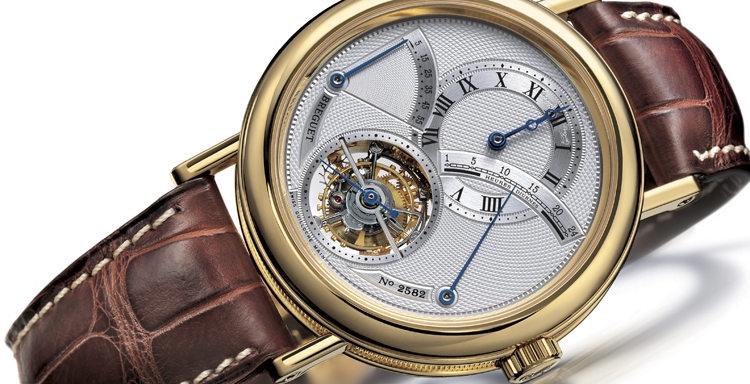Chronometer
Certified by an external testing body as being accurate within a specified deviation from true time under a variety of conditions. Each watch is tested individually. The only official testing body in the world is the COSC in Switzerland, issuing over a million certificates a year. Only 3% of Swiss production is certified. If it passes the tests a certification number is engraved on the movement and a certificate is issued. The most basic requirement is that the watch be accurate to within a mean of +/- 2 seconds a day. Rolex, Omega and Breitling between them submitted 1.1m movements for testing in 2001.
Chronograph
A Chronograph or chronoscope is a watch incorporating a stop-watch function – that is, an independent event timer. Typically an extra button on the outside case initiates, stops and returns an independent hand.
Perpetual Calendar
Translating the rules of the Gregorian Calendar into a mechanical expression is one of the most complex tasks. 365 days a year, 366 for leap years, except when the leap year ends in “00” is simple enough, and thankfully the cycle is only 100 years long. Should you be around long enough to want to have another 100 years use out of your wrist watch, a simple adjustment resets the watch to the beginning again, and thus you have a perpetual calendar. And all to save you the labour of adjusting your watch at the end of the month.
Minute Repeater
A chiming watch. Different chimes on the quarter, half and hour and every minute. And, critically, an off switch. Adding immense difficulty to the watch maker’s task of packing the movement into the tiny case, they nevertheless have their adherents among collectors and insomniacs.
Tourbillon
Invented by Breguet himself in 1795 to compensate for the effect of gravity on the escapement, particularly prevalent on the pocketed fob watches of the day. “Tourbillon” means “whirlwind”, and while the device is rotatory, it is hardly a whirlwind, taking a minute to make one turn. The escapement itself rotates, thus equalising the effect of gravity on a stationary watch. Hardly needed on a wristwatch in constant movement, a tourbillon is nevertheless a prized component in collectible watches.
Quartz
Anathema to the collector, whose passions are reserved for the mechanical wonders of tradition, nevertheless the technologies pioneered by the Swiss (and that almost destroyed the Swiss watch industry) make the most accurate watches possible. Accuracy is determined, ultimately, by the number of vibrations in a movement per second. The higher the better, and the more consistent the better. Quartz watches vibrate at much higher frequencies than the best mechanical watches.
Water Resistant
Resistance to water ingression depends on the pressure the water is under. Where once a manufacturer could claim his product was waterproof, it only took someone to go another 30ft deeper into the water to find out the watch was neither water- nor fool-proof. So a standard of resistance was devised. “Water-resistant” implies you can wash or stay out in the rain without considering your watch, but you should not swim. Thereafter the pressure that the case can withstand should be expressed in Atmospheres or depth of water. An Atmosphere is equivalent to 10m of water depth.
Power Reserve
The power stored in the mainspring either by manual winding or in an automatic by the normal movements of the wrist. Expressed in hours, this is how long the watch will run in a stationary position without being re-wound.
Shock Absorbing
The degree of shock designed for varies by the watch. Some are designed for the world of hard knocks, and can take a great deal of punishment, others for normal treatment. James Bond in On Her Majesty’s Secret Service famously breaks his Rolex Oyster Perpetual by using it as a knuckle-duster. He replaced it with the same watch, liking its weight and toughness, but was clearly using it beyond its design limitations, as Blofeld’s chalet guard found to his cost.
Jewel
When a watch has a label claiming so many “jewels”, it is referring to the natural or artificial precious stones used as low friction bearings. The more bearings that have jewels at friction points, the lower the friction overall. Jewel bearings have low stop-to-start friction as well as low running friction. There is a limit to how many jewels can be usefully employed, and the term has less marketing significance than it once had. The jewels are usually synthetic sapphires.
